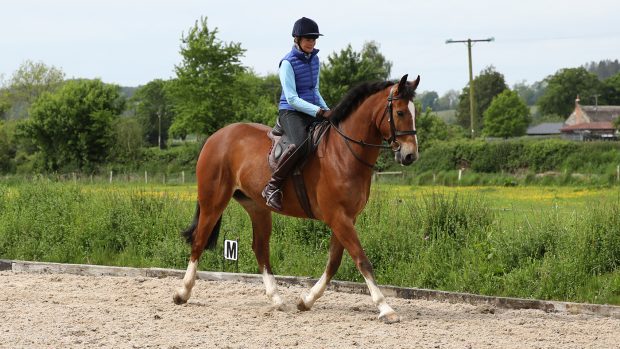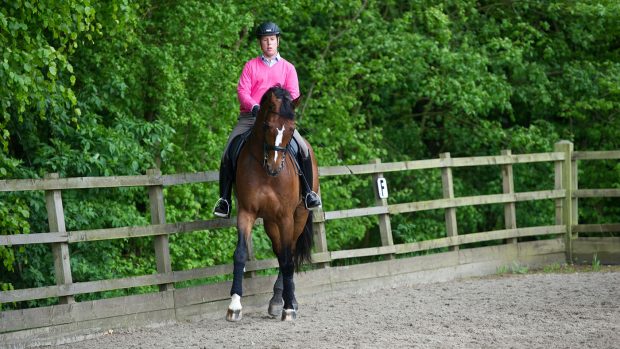The scales of training are the stepping stones we use to train our horses. They help us evaluate where our horses are in their education, and form the basis of how judges assess dressage tests. Also known as the German training scale, the scales of training are used across the world.
What are the scales of training?
The scales of training are rhythm, suppleness, contact, impulsion, straightness and collection. Each builds on the others and works together to achieve progression through the levels of dressage.
1. Rhythm
Rhythm is the regularity of the beats in all paces. The regularity is the correct sequence of the footfalls and the tempo is the speed of the rhythm.
2. Suppleness
Suppleness describes how a horse is moving in terms of resistance and considers pliability, ability to smoothly adjust the carriage (longitudinally) and the position (laterally) without impairing the flow of movement and balance.
3. Contact
Contact is the soft, steady connection between the rider’s hand and the horse’s mouth. Horses should go rhythmically forward from the rider’s driving aids and seek contact with the rider’s hand, going into the contact. The horse seeks the contact, while the rider provides the contact.
4. Impulsion
Impulsion is balanced energy and should not be confused with speed. It is the transmission of controlled, propulsive energy generated from the hindquarters into the athletic movement of the eager horse. Its ultimate expression can be shown only through the horse’s soft and swinging back, and is guided by the gentle contact with the rider’s hand.
5. Straightness
A horse shows straightness when its forehand is in line with its hindquarters, that is, when the longitudinal axis is in line with the straight or curved track it is following. A horse can still be described as straight when bending – the horse’s forefeet should always be aligned with the horse’s hind feet on straight and curved lines.
6. Collection
Collection is the increased engagement and activity of the hindlegs, with joints bent and supple, stepping forward under the horse’s belly. It is the re-balancing of the horse carrying the foreign weight of the rider and teaching him to carry more of the combined weight on his hindquarters rather than on his shoulders.
How to progress through the scales of training
The progression though these scales is rarely linear, and it can be frustrating trying to work out how all these attributes apply to your particular horse. At the 2019 British Dressage National Convention, held at Addington Equestrian Centre, British team medallist Michael Eilberg captivated the audience with his explanation of how the scales of training work — and sometimes don’t work — in tandem with each other.
“There are four basic things relating to the first phase of the scales of training: rhythm, balance, suppleness and relaxation,” explained Michael. “These are four core qualities that you never want to lose throughout any work that you do with your horse.”
Michael laid out four poles in a square shape with open corners, each pole representing one of these things.
“When I get on my horse I control speed, direction and outline, and if I can start to take an influence over those three things I start getting close to linking these four qualities together,” he continues, moving the poles one by one so they end up touching, in a closed square (pictured below), demonstrating how rhythm, balance, suppleness and relaxation all feed into each other.

When this is established in the early stages of training, Michael explains that a rider can start to work the horse forward into a stronger contact, as well as introducing impulsion. He sets up two boxes outside the square to represent each of these things, but explains that most of the time, when you start to bring contact or impulsion into the mix, it is initially at the expense of one of the four original “pillars”.
“For example, I can bring in impulsion, but initially only at the expense of good rhythm,” he says, placing one of the boxes in the middle of square and rolling away one pole to demonstrate this.
“So when that is the case, I have to take a step back and reintroduce contact or impulsion to a lesser extent, only up to the point at which one of the four pillars breaks away.
“Eventually, a horse should be able to accept contact and impulsion while also maintaining rhythm, balance, suppleness and relaxation, and then it is the same process with straightness and collection.”
Adding that this is a process that takes years, Michael also reminds the audience that once you have all these qualities securely in place and working together within your horse’s training, it doesn’t always stay that way.
“As years go by however, and your horse gains strength, these things do become more and more set in stone,” he concludes.
You might also be interested in:

Why the horse’s trot is the easiest pace to improve, plus other interesting facts

How to use your legs correctly when riding a horse: our ultimate guide

8 training gems from Carl Hester that could transform your dressage scores

Subscribe to Horse & Hound magazine today – and enjoy unlimited website access all year round
Horse & Hound magazine, out every Thursday, is packed with all the latest news and reports, as well as interviews, specials, nostalgia, vet and training advice. Find how you can enjoy the magazine delivered to your door every week, plus options to upgrade your subscription to access our online service that brings you breaking news and reports as well as other benefits.




